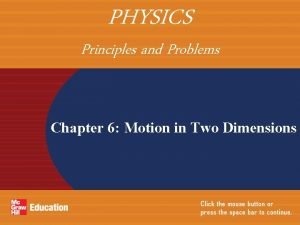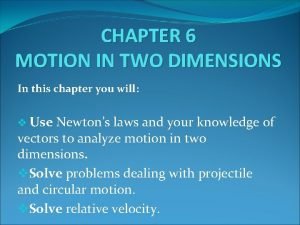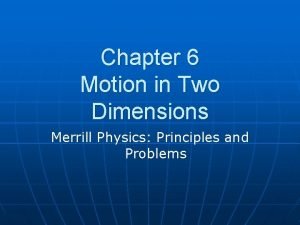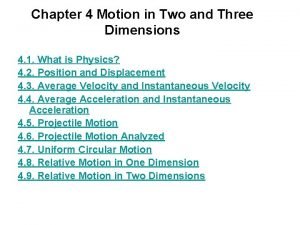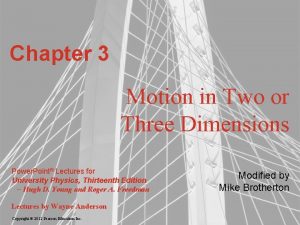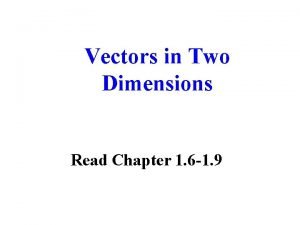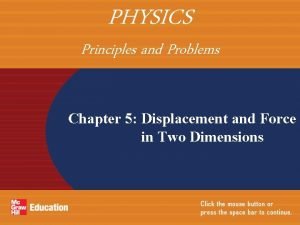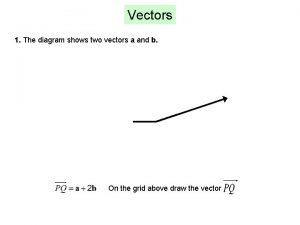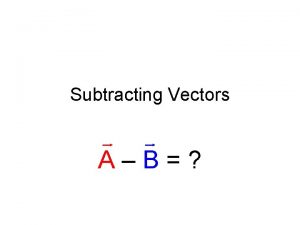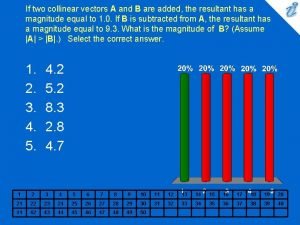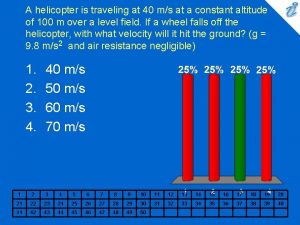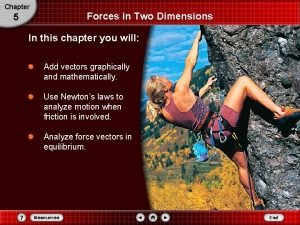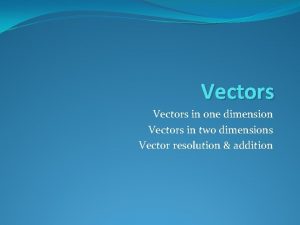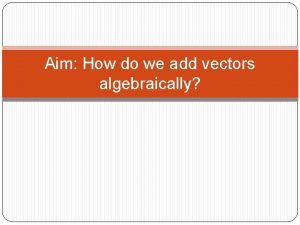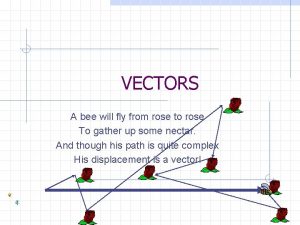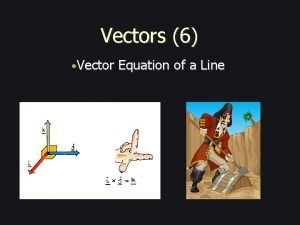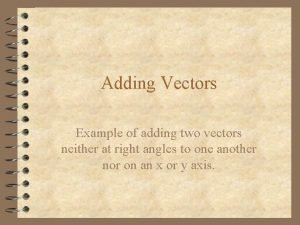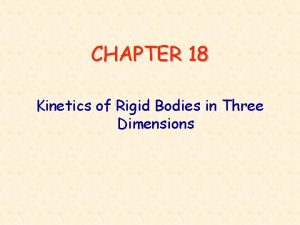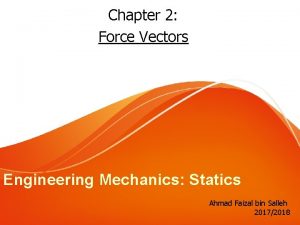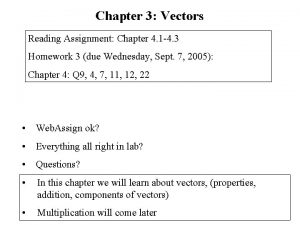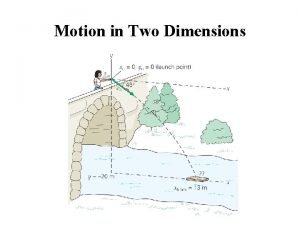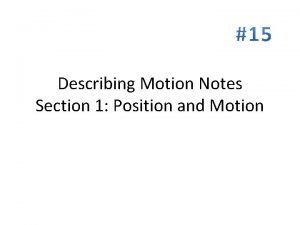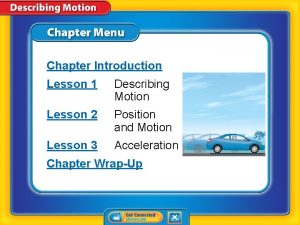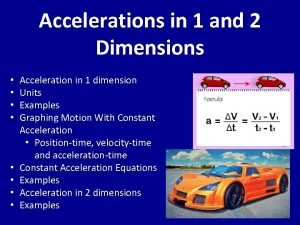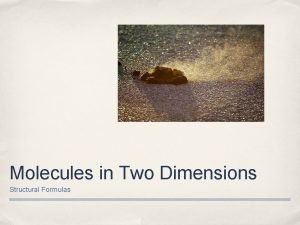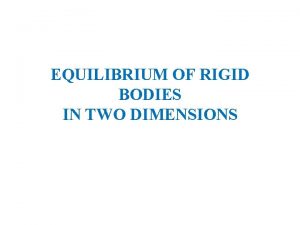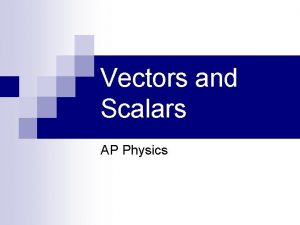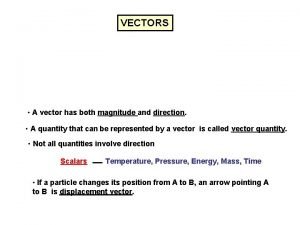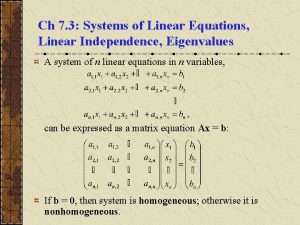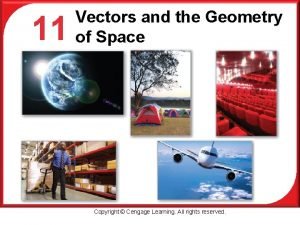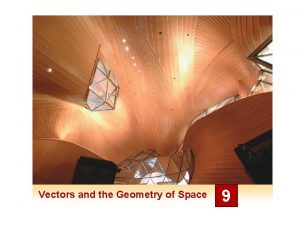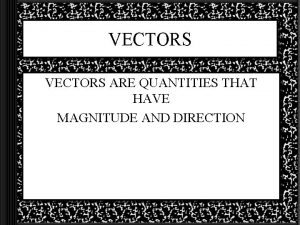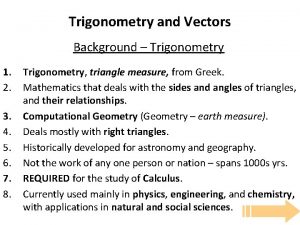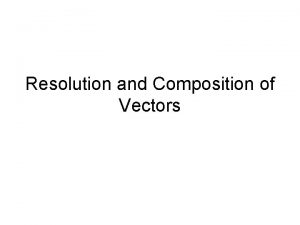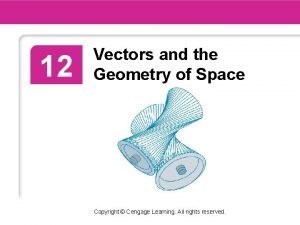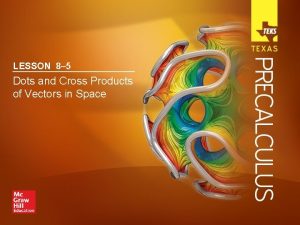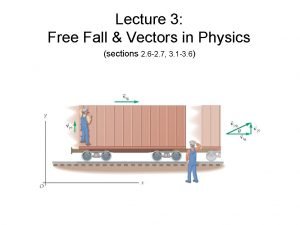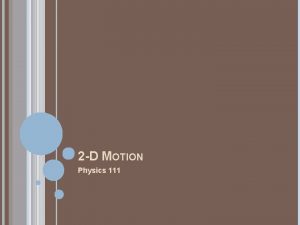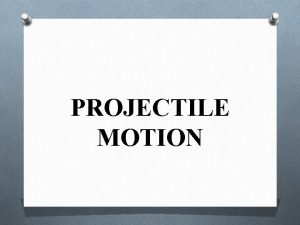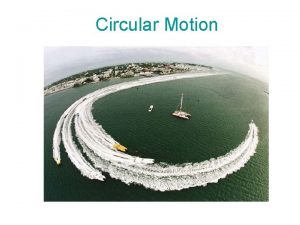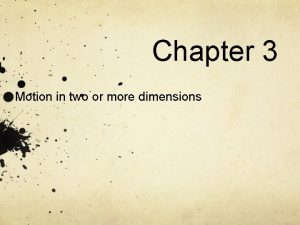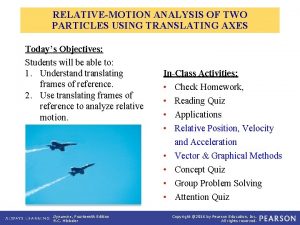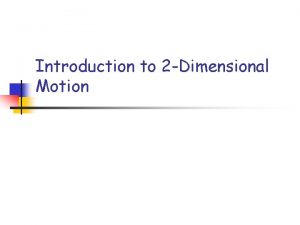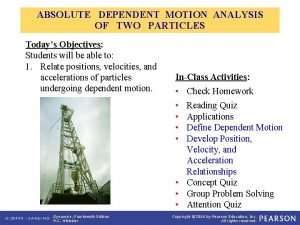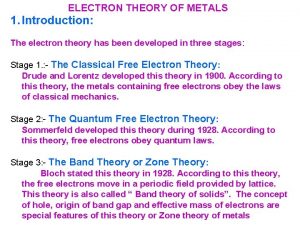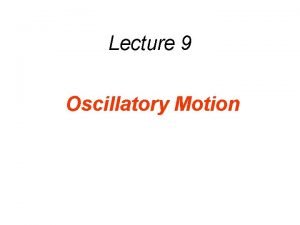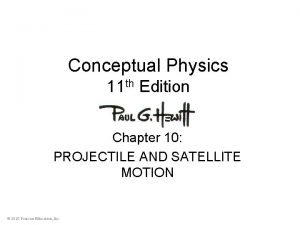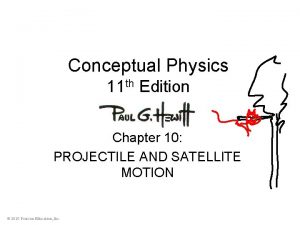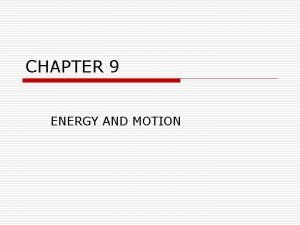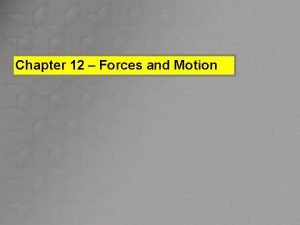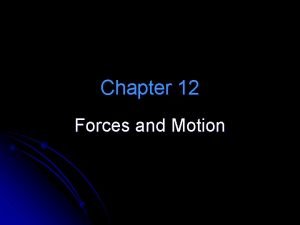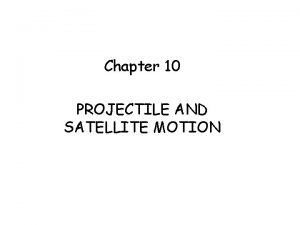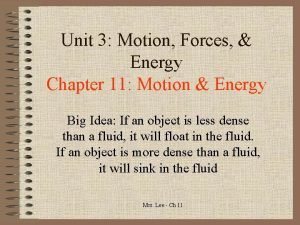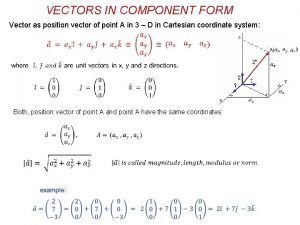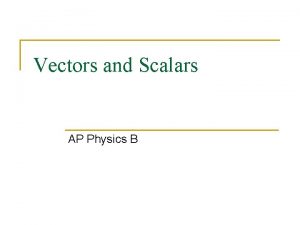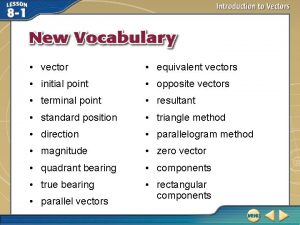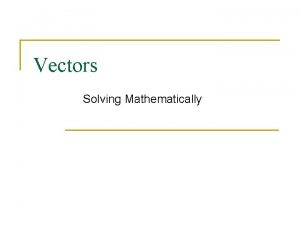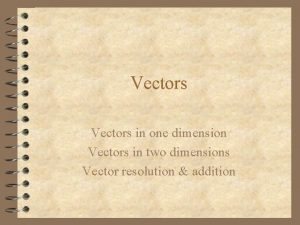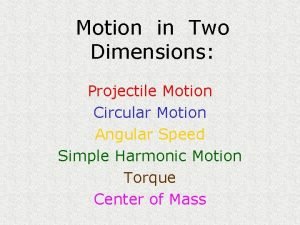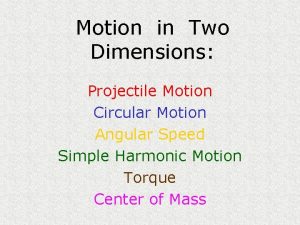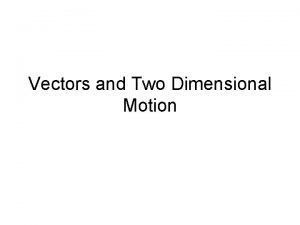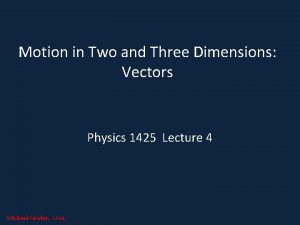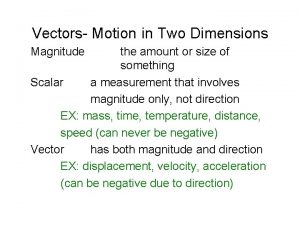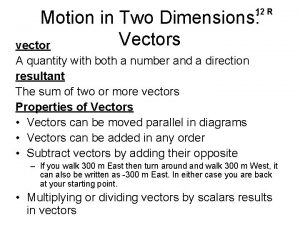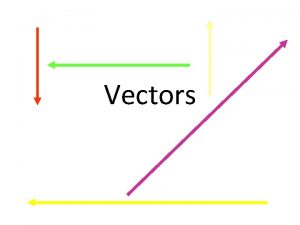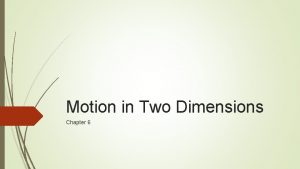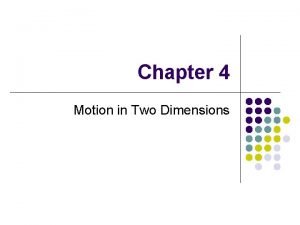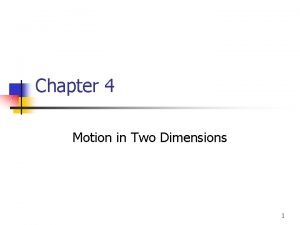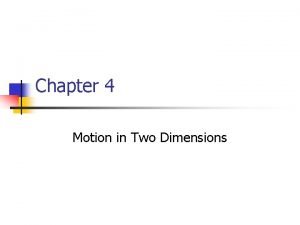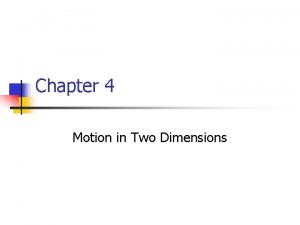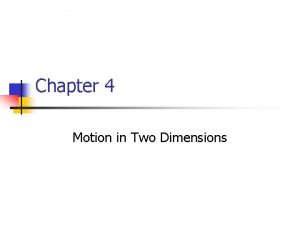Chapter 3 Vectors and Motion in Two Dimensions








































































































- Slides: 104

Chapter 3 • Vectors and Motion in Two Dimensions

Major Topics • • • Components of Vectors Vector Addition and Subtraction The Acceleration Vector Projectile Motion Circular Motion Relative Motion

3 Vectors and Motion in Two Dimensions Slide 3 -2

Slide 3 -3

Slide 3 -4

Slide 3 -5

Slide 3 -6

Vectors A vector has both magnitude and direction Would a vector be a good quantity to represent the temperature in a room?

Vectors Slide 3 -13

Coordinate systems Component Vectors

Components of Vectors Slide 3 -22

Vectors have components Projections onto an orthogonal coordinate system

Reading Quiz 1. Ax is the _____ of the vector A. A. magnitude B. x-component C. direction D. size E. displacement Slide 3 -7

Answer 1. Ax is the _____ of the vector A. A. magnitude B. x-component C. direction D. size E. displacement Slide 3 -8

Checking Understanding What are the x- and y-components of these vectors? A. B. C. D. E. 3, 2 2, 3 3, 2 2, 3 3, 2 Slide 3 -23

Checking Understanding What are the x- and y-components of these vectors? A. B. C. D. E. 3, 2 2, 3 3, 2 2, 3 3, 2 Slide 3 -23

Checking Understanding What are the x- and y-components of these vectors? A. B. C. D. E. 3, 1 3, 4 3, 3 4, 3 3, 4 Slide 3 -25

Answer What are the x- and y-components of these vectors? A. B. C. D. E. 3, 1 3, 4 3, 3 4, 3 3, 4 Slide 3 -26

• What is the magnitude of a vector with components (15 m, 8 m)? These bars take the magnitude of the vector argument

Vectors and Trigonometry The legs of a triangle depend on which angle were talking about hypotenuse opposite adjacent

Vectors and Trigonometry The legs of a triangle depend on which angle were talking about hypotenuse adjacent opposite

Vectors and Trigonometry The legs of a triangle depend on which angle were talking about hypotenuse opposite adjacent

Vectors and Trigonometry The legs of a triangle depend on which angle were talking about hypotenuse adjacent opposite

Using trig. functions SOH CAH hypotenuse adjacent opposite TOA

• Consider the vector b�with magnitude 4. 00 m at an angle 23. 5∘ north of east. What is the x component bx of this vector? 4 m 23. 5 Degrees

• Consider the vector b�with length 4. 00 m at an angle 23. 5∘ north of east. What is the y component by of this vector? 4 m 23. 5 Degrees

Checking Understanding The following vectors have length 4. 0 units. What are the x- and y-components of these vectors? A. B. C. D. E. 3. 5, 2. 0, 3. 5, 2. 0 Slide 3 -27

Answer The following vector has a length of 4. 0 units. What are the x- and y-components of this vector? A. B. C. D. E. 3. 5, 2. 0, 3. 5, 2. 0 Slide 3 -28

• What is the length of the shadow cast on the vertical screen by your 10. 0 cm hand if it is held at an angle of θ=30. 0∘ above horizontal? light 10. 0 cm d han 30 Degrees

• What is the angle above the x axis (i. e. , "north of east") for a vector with components (15 m, 8 m)?

Checking Understanding The following vectors have length 4. 0 units. What are the x- and y-components of these vectors? A. B. C. D. E. 3. 5, 2. 0, 3. 5, 2. 0 Slide 3 -29

Answer The following vectors have length 4. 0 units. What are the x- and y-components of these vectors? A. B. C. D. E. 3. 5, 2. 0, 3. 5, 2. 0 Slide 3 -30

• Consider the two vectors C�and D�, defined as follows: • C�=(2. 35, − 4. 27) and D�=(− 1. 30, − 2. 21). • What is the resultant vector R�=C�+D�?

Example Problem The labeled vectors each have length 4 units. For each vector, what is the component parallel to the ramp? The labeled vectors each have length 4 units. For each vector, what is the component perpendicular to the ramp? RA MP Slide 3 -31

Example Problem The labeled vectors each have length 4 units. For each vector, what is the component parallel to the ramp? The labeled vectors each have length 4 units. For each vector, what is the component perpendicular to the ramp? Slide 3 -31

Example Problem The labeled vectors each have length 4 units. For each vector, what is the component parallel to the ramp? The labeled vectors each have length 4 units. For each vector, what is the component perpendicular to the ramp? Slide 3 -31

Example Problem The labeled vectors each have length 4 units. For each vector, what is the component parallel to the ramp? The labeled vectors each have length 4 units. For each vector, what is the component perpendicular to the ramp? Slide 3 -31

Example Problem The labeled vectors each have length 4 units. For each vector, what is the component parallel to the ramp? The labeled vectors each have length 4 units. For each vector, what is the component perpendicular to the ramp? Slide 3 -31

Example Problems The Manitou Incline was an extremely steep cog railway in the Colorado mountains; cars climbed at a typical angle of 22 with respect to the horizontal. What was the vertical elevation change for the one-mile run along the track? 22 Slide 3 -32

Example Problems The maximum grade of interstate highways in the United States is 6. 0%, meaning a 6. 0 meter rise for 100 m of horizontal travel. a. What is the angle with respect to the horizontal of the maximum grade? Slide 3 -32

Example Problems The maximum grade of interstate highways in the United States is 6. 0%, meaning a 6. 0 meter rise for 100 m of horizontal travel. a. What is the angle with respect to the horizontal of the maximum grade? b. Suppose a car is driving up a 6. 0% grade on a mountain road at 67 mph (30 m/s). How many seconds does it take the car to increase its height by 100 m? Find displa cement Slide 3 -32

Example Problems The maximum grade of interstate highways in the United States is 6. 0%, meaning a 6. 0 meter rise for 100 m of horizontal travel. a. What is the angle with respect to the horizontal of the maximum grade? b. Suppose a car is driving up a 6. 0% grade on a mountain road at 67 mph (30 m/s). How many seconds does it take the car to increase its height by 100 m? OR Find displa cement Slide 3 -32

Vector Addition When adding vectors, bring the tip of one to the tail of the other

Application of vector addition 2 D Throw a ball up while moving on the motorcycle Speed of ball relative to ground y(meters) ? 10 m/s 5 10 Use the Pythagorean Theorem 2 m/s x(meters)

What is the ball’s speed? Solve for c 2 m/s 10 m/s

Checking Understanding Which of the vectors below best represents the vector sum P + Q? Slide 3 -16

Answer Which of the vectors below best represents the vector sum P + Q? A. Slide 3 -17

Answer Which of the vectors below best represents the vector sum P + Q? Slide 3 -17

Slide 3 -14

Vector Subtraction Flip this vector

Vector Subtraction

Checking Understanding Which of the vectors below best represents the difference P – Q? Slide 3 -18

Answer Which of the vectors below best represents the difference P – Q? B. Slide 3 -19

Checking Understanding Which of the vectors below best represents the difference Q – P? Slide 3 -20

Answer Which of the vectors below best represents the difference Q – P? C. Slide 3 -21

Using Vectors Examples of vectors: • Position • Velocity • Acceleration

Slide 3 -15

The Acceleration Vector Tilted system

Vectors in Motion Diagrams Acceleration is a change in velocity 0 s 1 s 2 s

Vectors in Motion Diagrams Acceleration is vector too 0 s 3 m/s 4 m/s 1 s 5 m/s 2 s

Vectors in Motion Diagrams Acceleration is vector too

Checking Understanding The diagram below shows two successive positions of a particle; it’s a segment of a full motion diagram. Which of the acceleration vectors best represents the acceleration between vi and vf? Slide 3 -33

Answer The diagram below shows two successive positions of a particle; it’s a segment of a full motion diagram. Which of the acceleration vectors best represents the acceleration between vi and vf? D. Slide 3 -34

Example Problems: Motion on a Ramp A new ski area has opened that emphasizes the extreme nature of the skiing possible on its slopes. Suppose an ad intones “Free fall skydiving is the greatest rush you can experience…but we’ll take you as close as you can get on land. When you tip your skis down the slope of our steepest runs, you can accelerate at up to 75% of the acceleration you’d experience in free fall. ” What angle slope could give such an acceleration? Slide 3 -35

Example Problems: Motion on a Ramp A new ski area has opened that emphasizes the extreme nature of the skiing possible on its slopes. Suppose an ad intones “Free fall skydiving is the greatest rush you can experience…but we’ll take you as close as you can get on land. When you tip your skis down the slope of our steepest runs, you can accelerate at up to 75% of the acceleration you’d experience in free fall. ” What angle slope could give such an acceleration? Slide 3 -35

Example Problems: Motion on a Ramp Ski jumpers go down a long slope on slippery skis, achieving a high speed before launching into air. The “in-run” is essentially a ramp, which jumpers slide down to achieve the necessary speed. A particular ski jump has a ramp length of 120 m tipped at 21 with respect to the horizontal. What is the highest speed that a jumper could reach at the bottom of such a ramp? Slide 3 -35

Example Problems: Motion on a Ramp Ski jumpers go down a long slope on slippery skis, achieving a high speed before launching into air. The “in-run” is essentially a ramp, which jumpers slide down to achieve the necessary speed. A particular ski jump has a ramp length of 120 m tipped at 21 with respect to the horizontal. What is the highest speed that a jumper could reach at the bottom of such a ramp? Slide 3 -35

Example Problems: Motion on a Ramp Ski jumpers go down a long slope on slippery skis, achieving a high speed before launching into air. The “in-run” is essentially a ramp, which jumpers slide down to achieve the necessary speed. A particular ski jump has a ramp length of 120 m tipped at 21 with respect to the horizontal. What is the highest speed that a jumper could reach at the bottom of such a ramp? Use 1 -D kinematic equation to find the Final velocity at the end of 120 m Slide 3 -35

Motion in 2 Dimensions Projectile Motion

Projectile Motion The horizontal motion is constant; the vertical motion is free fall: The horizontal and vertical components of the motion are independent. Slide 3 -37

Motion in 2 Dimensions Projectile Motion Each dimension independently follows the 1 D kinematic equations

Reading Quiz 2. The acceleration vector of a particle in projectile motion A. points along the path of the particle. B. is directed horizontally. C. vanishes at the particle’s highest point. D. is directed down at all times. E. is zero. Slide 3 -9

Answer 2. The acceleration vector of a particle in projectile motion A. points along the path of the particle. B. is directed horizontally. C. vanishes at the particle’s highest point. D. is directed down at all times. E. is zero. Slide 3 -10

Slide 3 -38

Slide 3 -39

Example Problem: Projectile Motion In the movie Road Trip, some students are seeking to jump a car across a gap in a bridge. One student, who professes to know what he is talking about (“Of course I’m sure—with physics, I’m always sure. ”), says that they can easily make the jump. He gives the following data: The car weighs 2100 pounds, with passengers and luggage. Right before the gap, there’s a ramp that will launch the car at an angle of 30°. The gap is 10 feet wide. He then suggests that they should drive the car at a speed of 50 mph in order to make the jump. a. If the car actually went airborne at a speed of 50 mph at an angle of 30° with respect to the horizontal, how far would it travel before landing? b. Does the mass of the car make any difference in your calculation? Slide 3 -40

Example Problem: Projectile Motion The car weighs 2100 pounds, with passengers and luggage. Right before the gap, there’s a ramp that will launch the car at an angle of 30°. The gap is 10 feet wide. He then suggests that they should drive the car at a speed of 50 mph in order to make the jump. a. If the car actually went airborne at a speed of 50 mph at an angle of 30° with respect to the horizontal, how far would it travel before landing? b. Does the mass of the car make any difference in your calculation? 10 ft Slide 3 -40

Example Problem: Projectile Motion The car weighs 2100 pounds, with passengers and luggage. Right before the gap, there’s a ramp that will launch the car at an angle of 30°. The gap is 10 feet wide. He then suggests that they should drive the car at a speed of 50 mph in order to make the jump. a. If the car actually went airborne at a speed of 50 mph at an angle of 30° with respect to the horizontal, how far would it travel before landing? b. Does the mass of the car make any difference in your calculation? 10 ft 0 Find the amount of time the car spends in the air Slide 3 -40

Example Problem: Projectile Motion The car weighs 2100 pounds, with passengers and luggage. Right before the gap, there’s a ramp that will launch the car at an angle of 30°. The gap is 10 feet wide. He then suggests that they should drive the car at a speed of 50 mph in order to make the jump. a. If the car actually went airborne at a speed of 50 mph at an angle of 30° with respect to the horizontal, how far would it travel before landing? b. Does the mass of the car make any difference in your calculation? 10 ft Use that time to find how far he went horizontally before he hit the ground with the horizontal speed = distance/time formula Slide 3 -40

Example Problem: Broad Jumps A grasshopper can jump a distance of 30 in (0. 76 m) from a standing start. If the grasshopper takes off at the optimal angle for maximum distance of the jump, what is the initial speed of the jump? Most animals jump at a lower angle than 45°. Suppose the grasshopper takes off at 30° from the horizontal. What jump speed is necessary to reach the noted distance? Same as car jump problem Slide 3 -41

Example Problem Alan Shepard took a golf ball to the moon during one of the Apollo missions, and used a makeshift club to hit the ball a great distance. He described the shot as going for “miles and miles. ” A reasonable golf tee shot leaves the club at a speed of 64 m/s. Suppose you hit the ball at this speed at an angle of 30 with the horizontal in the moon’s gravitational acceleration of 1. 6 m/s 2. How long is the ball in the air? How far would the shot go? Same as car jump problem Slide 3 -42

Circular Motion Uniform circular motion Not speeding up but changing directions

Circular Motion There is an acceleration because the velocity is changing direction. Slide 3 -43

Example Problems: Circular Motion Two friends are comparing the acceleration of their vehicles. Josh owns a Ford Mustang, which he clocks as doing 0 to 60 mph in a time of 5. 6 seconds. Josie has a Mini Cooper that she claims is capable of higher acceleration. When Josh laughs at her, she proceeds to drive her car in a tight circle of 10 ft at 13 mph. Which car experiences a higher acceleration? Slide 3 -44

Example Problems: Circular Motion Turning a corner at a typical large intersection in a city means driving your car through a circular arc with a radius of about 25 m. If the maximum advisable acceleration of your vehicle through a turn on wet pavement is 0. 40 times the free-fall acceleration, what is the maximum speed at which you should drive through this turn? Slide 3 -44

Motion in 2 Dimensions Circular Motion Centripetal acceleration

• A garden has a circular path of radius 50 m. John starts at the easternmost point on this path, then walks counterclockwise around the path until he is at its southernmost point. What is the magnitude of John's displacement?

Reading Quiz 3. The acceleration vector of a particle in uniform circular motion A. points tangent to the circle, in the direction of motion. B. points tangent to the circle, opposite the direction of motion. C. is zero. D. points toward the center of the circle. E. points outward from the center of the circle. Slide 3 -11

Answer 3. The acceleration vector of a particle in uniform circular motion A. points tangent to the circle, in the direction of motion. B. points tangent to the circle, opposite the direction of motion. C. is zero. D. points toward the center of the circle. E. points outward from the center of the circle. Slide 3 -12

Relative Motion Relative Velocity Plane speed (relative to wind) wind What about plane speed relative to the ground?

Relative Motion Use vector subtraction to find the plane speed relative to the ground Plane speed (relative to ground) wind Plane speed (relative to wind)

• You try to swim directly across the river at a speed of 1. 00 m/s. What does your friend see? Swimming velocity Velocity relative to the shore Water velocity

• This time you try to make it look like your swimming directly across the river to your friend on the shore. What velocity would you need to do this? Swimming velocity Velocity relative to the shore Water velocity

You're driving down the highway late one night at 18 m/s when a deer steps onto the road 44 m in front of you. Your reaction time before stepping on the brakes is 0. 50 s , and the maximum acceleration of your car is -11 m/s/s How much distance is between you and the deer when you come to a stop? What is the maximum speed you could have and still not hit the deer?

Example Problems: Relative Motion An airplane pilot wants to fly due west from Spokane to Seattle. Her plane moves through the air at 200 mph, but the wind is blowing 40 mph due north. In what direction should she point the plane—that is, in what direction should she fly relative to the air? wind Slide 3 -36

Example Problems: Relative Motion A skydiver jumps out of an airplane 1000 m directly above his desired landing spot. He quickly reaches a steady speed, falling through the air at 35 m/s. There is a breeze blowing at 7 m/s to the west. At what angle with respect to vertical does he fall? When he lands, what will be his displacement from his desired landing spot? 7 m/s wind 30 m/s Slide 3 -36

Example Problems: Relative Motion A skydiver jumps out of an airplane 1000 m directly above his desired landing spot. He quickly reaches a steady speed, falling through the air at 35 m/s. There is a breeze blowing at 7 m/s to the west. At what angle with respect to vertical does he fall? When he lands, what will be his displacement from his desired landing spot? wind 7 m/s 30 m/s Slide 3 -36

MCAT style question • At the end of the first section of the motion, riders are moving at what approximate speed? A. B. C. D. 3 m/s 6 m/s 9 m/s 12 m/s

MCAT style question • Suppose the acceleration during the second section of the motion is too large to be comfortable for riders. What change could be made to decrease the acceleration during this section? A. B. C. D. reduce the radius of the circular segment increase the angle of the ramp increase the length of the ramp

MCAT style question • What is the vertical component of the velocity of the rider just before he/she hits the water? A. B. C. D. 2. 4 m/s 3. 4 m/s 5. 2 m/s 9. 1 m/s

MCAT style question • Suppose the designers of the water slide want to adjust the height above the water so that riders land twice as far away from the bottom of the slide. What would be the necessary height above the water? A. B. C. D. 1. 2 m 1. 8 m 2. 4 m 3. 0 m

MCAT style question • During which section of the motion is the magnitude of the acceleration experienced by a rider the greatest? A. B. C. D. first second third They’re all the same

Summary Slide 3 -45

Summary Slide 3 -46
 Two dimensional motion examples
Two dimensional motion examples Chapter 6 study guide motion in two dimensions
Chapter 6 study guide motion in two dimensions A 45-kg merry-go-round worker
A 45-kg merry-go-round worker Chapter 6 motion in two dimensions
Chapter 6 motion in two dimensions Chapter 6 motion in two dimensions
Chapter 6 motion in two dimensions Motion in two and three dimensions
Motion in two and three dimensions Motion in two or three dimensions
Motion in two or three dimensions Vectors quick check
Vectors quick check Quickchek menu
Quickchek menu Vectors in 2 dimensions
Vectors in 2 dimensions Chapter 5 displacement and force in two dimensions
Chapter 5 displacement and force in two dimensions The diagram shows a hexagon abcdef
The diagram shows a hexagon abcdef The diagram shows two vectors that point west and north.
The diagram shows two vectors that point west and north. Collinear vectors
Collinear vectors A student adds two vectors with magnitudes of 200 and 40
A student adds two vectors with magnitudes of 200 and 40 Forces in two dimensions worksheet answers
Forces in two dimensions worksheet answers Chapter 2 motion section 1 describing motion answer key
Chapter 2 motion section 1 describing motion answer key Describing and measuring motion
Describing and measuring motion Motion section 1 describing motion
Motion section 1 describing motion Resultant of like parallel forces
Resultant of like parallel forces Dot product of two vectors
Dot product of two vectors Vectors in two dimension
Vectors in two dimension How to add vectors algebraically
How to add vectors algebraically Dot product
Dot product Parallel vectors
Parallel vectors Cross product of two vectors
Cross product of two vectors Adding two vectors together
Adding two vectors together Kinetic of rigid body
Kinetic of rigid body A 100 lb weight hangs from two wires
A 100 lb weight hangs from two wires Dot product
Dot product 4^x = 256
4^x = 256 Range of motion active and passive
Range of motion active and passive Chapter 2 force vectors solutions
Chapter 2 force vectors solutions Chapter 3 vectors worksheets
Chapter 3 vectors worksheets This chapter shows how vectors can be added using
This chapter shows how vectors can be added using Acceleration in two dimensions
Acceleration in two dimensions Two dimensions of political ideologies
Two dimensions of political ideologies Horizontal velocity projectile motion
Horizontal velocity projectile motion Describing position in two dimensions
Describing position in two dimensions Position and motion
Position and motion Dimension of acceleration
Dimension of acceleration What is two dimensional media
What is two dimensional media Molecules in two dimensions structural formulas
Molecules in two dimensions structural formulas Equilibrium in two dimensions
Equilibrium in two dimensions Chapter 6 strategy analysis and choice
Chapter 6 strategy analysis and choice Spiral model dimensions
Spiral model dimensions Example of multimodal text
Example of multimodal text Shm equation of motion
Shm equation of motion An object in motion stays in motion
An object in motion stays in motion Describing motion worksheet answer key
Describing motion worksheet answer key Motion section 1 describing motion
Motion section 1 describing motion Chapter 2 representing motion chapter assessment
Chapter 2 representing motion chapter assessment Vector directed line segment
Vector directed line segment A storm system moves 5000 km due east
A storm system moves 5000 km due east Collinear vectors
Collinear vectors Physics vectors
Physics vectors A vector has both magnitude and
A vector has both magnitude and Example of vector
Example of vector Scalars and vectors
Scalars and vectors Definition of vector space
Definition of vector space Linearly dependent and independent vectors
Linearly dependent and independent vectors Vectors and the geometry of space
Vectors and the geometry of space Conditions for linear independence
Conditions for linear independence Dot product
Dot product Lesson plan on vectors and scalars
Lesson plan on vectors and scalars Magnitude of vector
Magnitude of vector Trigonometry and vectors
Trigonometry and vectors Resolution and composition of vectors
Resolution and composition of vectors Matrix multiplication simulink
Matrix multiplication simulink Physical quantities of vectors
Physical quantities of vectors Physical quantities units and measurement
Physical quantities units and measurement Magnitude of unit vector formula
Magnitude of unit vector formula Vectors and the geometry of space
Vectors and the geometry of space 8-5 practice dot and cross products of vectors in space
8-5 practice dot and cross products of vectors in space Free fall
Free fall You are adding vectors of length 20 and 40 units
You are adding vectors of length 20 and 40 units Legal safeguards in nursing practice
Legal safeguards in nursing practice Does weight affect projectile motion
Does weight affect projectile motion Define projectile motion in physics
Define projectile motion in physics What is circular motion give two examples
What is circular motion give two examples Two dimensional motion
Two dimensional motion Relative motion of two particles using translating axes
Relative motion of two particles using translating axes Two dimensional motion definition
Two dimensional motion definition A circular motion is one dimensional
A circular motion is one dimensional Position and motion
Position and motion Electron theory of metals
Electron theory of metals Oscillation
Oscillation Chapter 9 motion and energy answer key
Chapter 9 motion and energy answer key Section 3 motion and forces worksheet answers
Section 3 motion and forces worksheet answers Conceptual physics projectile motion
Conceptual physics projectile motion Chapter 10 projectile and satellite motion tossed ball
Chapter 10 projectile and satellite motion tossed ball Chapter 9 motion and energy answer key
Chapter 9 motion and energy answer key Laws of motion
Laws of motion Chapter 12 forces and motion
Chapter 12 forces and motion Chapter 10 projectile and satellite motion tossed ball
Chapter 10 projectile and satellite motion tossed ball Mrs lee chapter 11
Mrs lee chapter 11 /scriptimg srcx onerroralert1
/scriptimg srcx onerroralert1 Vector vs scalar examples
Vector vs scalar examples Adding multiple vectors
Adding multiple vectors A storm system moves 5000 km due east
A storm system moves 5000 km due east Vector form
Vector form Decomposing vectors
Decomposing vectors 700 calories scalar or vector
700 calories scalar or vector Equivalent vectors
Equivalent vectors Chickerings 7 vectors
Chickerings 7 vectors

